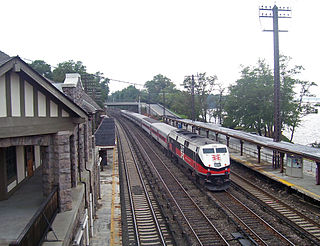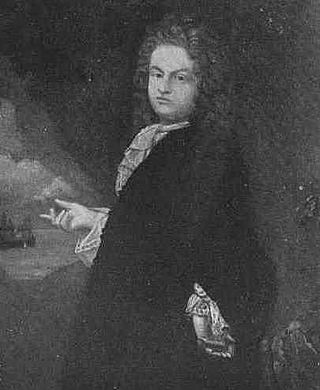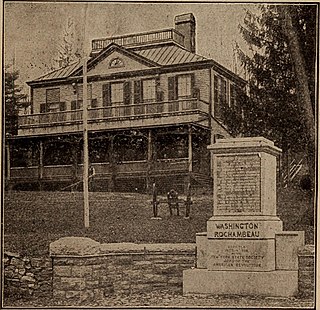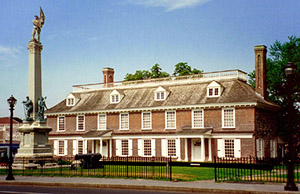
Sleepy Hollow is a village in the town of Mount Pleasant in Westchester County, New York, United States.

Philipse Manor station is a commuter rail stop on the Metro-North Railroad's Hudson Line, located in the Philipse Manor area of Sleepy Hollow, New York, United States.

Wolfert Acker (1667–1753) was a colonial-period American who is featured in Washington Irving's short story collection Wolfert's Roost and Miscellanies (1855). His name was recorded in all combinations of Wolfert or Wolvert as given name, and Acker, Echert, Eckar, or Ecker as surname. He was born in Flatbush, Brooklyn, New York and died at his sizable home, "Wolfert's Roost" near the site of what is now Irvington, New York in Westchester County, New York. On December 20, 1692, on land belonging to Frederick Philipse, he married Maretje Sibouts.

Pinkster is a spring festival, taking place in late May or early June. The name is a variation of the Dutch word Pinksteren, meaning "Pentecost". Pinkster in English refers to the festivals held by the Black population of New York and New Jersey, particularly in the early 19th century. To the Dutch, Pinkster was a religious holiday, a chance to rest, gather and celebrate religious services like baptisms and confirmations. It also had a long tradition as a day of dance and merriment. For enslaved people, Pinkster was a time free from work and a chance to gather and catch up with family and friends.
Philipse Manor may refer to:

The Saw Mill River is a 23.5-mile (37.8 km) tributary of the Hudson River in Westchester County, New York, United States. It flows from an unnamed pond north of Chappaqua to Getty Square in Yonkers, where it empties into the Hudson as that river's southernmost tributary. It is the only major stream in southern Westchester County to drain into the Hudson instead of Long Island Sound. It drains an area of 26.5 square miles (69 km2), most of it heavily developed suburbia. For 16 miles (26 km), it flows parallel to the Saw Mill River Parkway, a commuter artery, an association that has been said to give the river an "identity crisis."

The Old Dutch Church of Sleepy Hollow (Dutch: Oude Nederlandse Kerk van Sleepy Hollow), listed on the National Register of Historic Places as Dutch Reformed Church (Sleepy Hollow), is a 17th-century stone church located on Albany Post Road (U.S. Route 9) in Sleepy Hollow, New York, United States. It and its three-acre (1.2 ha) churchyard feature prominently in Washington Irving's 1820 short story "The Legend of Sleepy Hollow". The churchyard is often confused with the contiguous but separate Sleepy Hollow Cemetery.

Frederick Philipse, first Lord of the Manor of Philipseborough and patriarch of the Philipse family, was a Dutch immigrant to North America of Bohemian heritage. A merchant, he arrived in America as early as 1653. In 1662, he married Margaret Hardenbrook de Vries, a wealthy and driven widow. Together, and variously in league with slavers, pirates, and other undesirables alongside the prominent and respectable, the couple amassed a fortune.
Jacobus van Cortlandt (1658–1739) was a wealthy New Amsterdam-born American merchant, slave owner, and politician who served as the 30th and 33rd Mayor of New York City from 1710 to 1711 and again from 1719 to 1720.
Historic Hudson Valley is a not-for-profit educational and historic preservation organization headquartered in Tarrytown, New York. The organization runs tours and events at five historic properties in Westchester County, in the lower Hudson River Valley.

Wye House is a historic residence and former headquarters of a historic plantation house northwest of Easton in rural Talbot County, Maryland. Built in 1781–1784, it is a high-quality and well-proportioned example of a wooden-frame Southern plantation house. It was designated a National Historic Landmark in 1970.

Philipsburg Manor was a manor located north of New York City in Westchester County in the Province of New York. Netherlands-born Frederick Philipse I and two partners made the initial purchase of land that had been part of a Dutch patroonship owned by Adriaen van der Donck. Philipse subsequently bought his partners out and added more land before being granted a royal charter in 1693 for the 52,000 acres (21,000 ha) estate, becoming its first lord.

Hyatt-Livingston House was an historic home located at Dobbs Ferry, Westchester County, New York, at the corner of Colonial Avenue and Broadway. Originally constructed as part of the Philipsburg Manor around 1690 by land baron Frederick Philipse, the house was at first a smaller tenant-farmer's dwelling home to the John Hyatt family. In 1705, Hyatt's daughter Elizabeth married neighbor John Dobbs, who originally brought that family name to the area and perhaps started the ferry for which the village is named. In the early 18th century, the house was enlarged to a five-bay, 2+1⁄2-story dwelling that then formed the central part of the house. It was of wood-frame construction, with a gable roof, and sat on a fieldstone foundation.

Philipse Manor Hall State Historic Site is a historic house museum located in the Getty Square neighborhood of Yonkers, New York. Originally the family seat of Philipse Manor, and later Yonkers city hall, it is Westchester County's second oldest standing building after the Timothy Knapp House. Located near the Hudson River at Warburton Avenue and Dock Street, it is owned and operated by the New York State Office of Parks, Recreation and Historic Preservation.

The Pocantico River is a nine-mile-long (14 km) tributary of the Hudson River in western central Westchester County, New York, United States. It rises from Echo Lake, in the town of New Castle south of the hamlet of Millwood, and flows generally southwest past Briarcliff Manor to its outlet at Sleepy Hollow. Portions of the towns of Mount Pleasant and Ossining are within its 16-square-mile (41 km2) watershed.

The history of Westchester County, a county in the state of New York, can be traced back to the founding of a settlement between the Hudson River and Long Island Sound in the 17th century. The area now known as Westchester County had seen human occupation since at least the Archaic period, but significant growth in the settlements that are now incorporated into the county did not occur until the Industrial Revolution.
There are numerous nationally and locally designated historic sites and attractions in Westchester County. These include architecturally significant manors and estates, churches, cemeteries, farmhouses, African-American heritage sites, and Underground Railroad depots and waystations. There are sites from pre-Revolutionary and Revolutionary times, as well as battlegrounds. Westchester County also played an important role in the development of the modern suburb, and there are many associated heritage sites and museums.

Frederick Philipse II was a merchant, landowner, and politician in British America. He was the only son of Maria Sparkes, daughter of the Governor of Barbados, and Philip Philipse, eldest son of Frederick Philipse I, 1st Lord of the Philipsburg Manor. Philip predeceased his father, and family lands passed on to younger son Adolphus Philipse. Upon his uncle's death Frederick II inherited his share of Philipse lands and commercial interests, thereafter becoming the elder Philipse male and 2nd Lord of Philipsburg Manor.

Frederick Philipse III was the third and last Lord of Philipsburg Manor, a 52,000 acres (21,000 ha) hereditary estate in lower Westchester County, New York, and a Loyalist during the Revolutionary War.

The African American Heritage Trail of Westchester County in New York was created in 2004 to help preserve and interpret the historic landmark places that help tell the narratives of women and men of African descent who have made significant contributions to an American identity. The initial list had 13 sites. Westchester County historian and Schulman History Honoree Dr. Larry Spruill was lead consultant and researcher for the project.





















